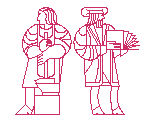

6.301 is analog circuit analysis and design. We cover the tools and methods necessary for the creative design of useful circuits using active devices. The class stresses insight and intuition, applied to the design of transistor circuits and the estimation of their performance. We concentrate on circuits using the bipolar junction transistor, but the techniques that we study can be equally applied to circuits using JFETs, MOSFETs, MESFETs, future exotic devices, or even vacuum tubes.
Transistor circuits from the single-transistor common-emitter amplifier to op amps, multipliers, references, and high speed logic. High-frequency analysis and design techniques. Open-circuit time constants, op amps, transimpedance amps, translinear circuits, bandgap references, and the charge control model.Circuit examples from commerical products including the uA733 video amp, the LM172 AGC AM IF strip, the uA741 internally compensated op amp, the LM101 externally compensated op amp, the LM118 high-speed op amp, the LF155 jfet op amp, the OP07 low-offset op amp, the TL081 jfet op amp, the LM108 super-beta op amp, the 7805 voltage regulator, the LH0091 RMS-to-DC converter, the LM1496 multiplier, the AD532 multiplier, and many others.
Datasheets shamelessly stolen from National Semiconductor, Analog Devices, and Texas Instruments.
You will have two or three laboratory projects during the term. You will analyze, build, and test several circuits of your own design. We believe real laboratory experience is extremely important for truly learning the art of design. Some previous laboratory work (the use of function generators and oscilloscopes) is assumed.
6.301 uses the semiconductor physics and transistor circuit models developed in 6.012 for the analysis and design of transistor circuits. Thus 6.012 is the official prerequisite. However, permission is sometimes granted to certain highly self-motivated students to substitute 6.101, take 6.012 as a corequisite, or simply take 6.301 without 6.012. Consult the staff for details.Suggested reading: "All you really need to know about device physics to take 6.301."
Since 6.003 is a corequisite for 6.012, it is also a necessary prerequisite for 6.301. We will make extensive use of Bode plots, Laplace transforms, circuit transfer functions, and complex-impedance methods.
Note that books 3 and 5 have different first authors. Paul R. Gray (aka Evil Paul Gray) was Executive Vice Chancellor and Provost of UC Berkeley. Paul E. Gray (aka Good Paul Gray) was the former president and chairman of MIT.
- Kent H. Lundberg. Become One with the Transistor. Unpublished, 2019. (Required.)
- Robert A. Pease. Troubleshooting Analog Circuits. Butterworth-Heinemann, Boston, 1991. (Strongly recommended.)
- Paul R. Gray, Paul J. Hurst, Stephen H. Lewis, and Robert G. Meyer. Analysis and Design of Analog Integrated Circuits (fourth edition). Wiley, New York, 2001. (Strongly recommended.)
- Alan B. Grebene. Bipolar and MOS Analog Integrated Circuit Design. Wiley, New York, 1984. (Recommended, now in inexpensive paperback.)
- Paul E. Gray and Campbell L. Searle. Electronic Principles: Physics, Models, and Circuits. Wiley, New York, 1969. (Out of print, but still suggested.)
Please note: The SPICE models included in these datasheets are worthless. For example, for the 2N3904, while the datasheet says that beta can be between 100 and 300, the SPICE model assumes that it is greater than 400. This value is criminally optimistic. Do not use the datasheet SPICE models in your own simulations.
We want our simulations to match our hand calculations and our lab measurements. SPICE is only as good as the model we give it. If the list of hybrid-pi parameters (under the ``bipolar junction transistors subckt'' heading) from SPICE doesn't match our calculations exactly (within a few percent), then something is wrong with our model. It is well worth our time to make a few measurements in lab (using the curve tracer to find current gain and output resistance, and the impedance meter to find parasitic capacitances) and a few hand calculations (using the datasheet values for f_T and V_BE to find tau_F and I_S) to create our own model.